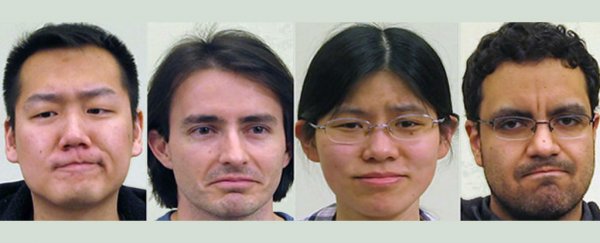As humans, we've got access to a great variety of facial expressions that can signify many different emotions without us needing to utter a single word. Anywhere you go in the world, a smile is a smile and a frown is a frown. Our facial expressions connect us as a species, no matter how many cultural boundaries we might encounter.
And now, researchers from Ohio State University say they've identified a new facial expression - which they've dubbed the 'Not Face' - and you probably use it more often than you think.
According to the team, the Not Face is a way to instantly convey that you disagree with a statement. It's used when someone furrows their brow, presses their lips together and raises their chin - a combination of three well-known expressions: anger, disgust, and contempt. It basically looks like a lazy frown. If you try to recall the last argument you had, you can probably remember making such a face.
The Not Face isn't constrained by country or culture, either. The team reports that the Not Face is universal to the point that American Sign Language (ASL) speakers sometimes use the Not Face instead of signing the word for "not".
Though that may not sound all that surprising, it's actually the first time researchers have identified a facial expression that replaces an actual word in ASL, which hints that the Not Face is intrinsically connected to human communication.
To study the expression, the team had 158 participants sit in front of a camera and have a conversation with one of the researchers. The group of participants was made up of speakers of four different languages: English, Spanish, Mandarin Chinese, and ASL. These speakers were chosen because their languages all evolved from different grammatical structures.
The team then had the participants recite negative sentences or asked them disagreeable questions and recorded the responses. When that was over with, they went back through the footage and looked at how each person's face changed when disagreeing. Based on a frame-by-frame analysis, the team found that all groups used the Not Face inside their statements.
"This facial expression not only exists, but in some instances, it is the only marker of negation in a signed sentence," said one of the team, Aleix Martinez. "Sometimes the only way you can tell that the meaning of the sentence is negative is that person made the 'not face' when they signed it."
To study the Not Face further, the team plans to come up with an algorithm that can detect and record the expression without researchers needing to go through all the video footage at a snail's pace. Once the algorithm is in place, the researchers are then hoping to analyse thousands of hours of YouTube videos to amass a far more representative pool of data than what they can get from 158 participants, with the end goal being 10,000 hours of study.
The findings will hopefully give researchers the ability to study how language was first created, and how it evolved over time. Since the Not Face is so universal, it's a prime candidate to answer some fundamental questions about how our communication techniques have changed over millennia.
The team's findings were recently published in the journal Cognition.
